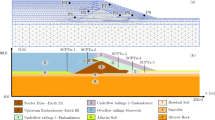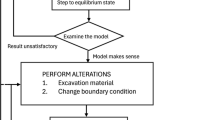Abstract
The stability of underground voids such as caves can be assessed, in an initial approximation, by geomechanical classifications such as the Barton Q index. From a geomechanical viewpoint, the stability of 137 large span natural caves was analyzed herein. The caves were graphically represented based on existing tunnel and underground graphs, according to width and rock quality index Q. Many natural caves analyzed by a tunnel-type engineering approach could result as apparently unstable when represented in empirical existing graphics and would require reinforcements incompatible with speleothems and large chamber heights. A new graph and equation are proposed herein for the maximum span, for the exclusive case of caves, resulting in a reliable representation of large stable natural caves. The main contribution is a new stability chart for natural caves, consisting of two zones: a zone where stable caves are represented and a zone where unstable caves and collapsed caves are located.








Similar content being viewed by others
References
3D Caves Project (2015) The world´s voids in 3D. Descent 245:34–43
Barton N (1976) Unsupported underground openings.- Rock Mechanics Discussion Meeting. Befo, Swedish Rock Mechanics Research Foundation, Stockholm, pp 61–94
Barton N (2014) Estimating the shear strengh of rock joints. Proc. of 3rd Congr. Int. Soc. Rock Mech. Advances in rock mechanics, Denver, Vol IIA, pp 219–220
Barton N, Bieniawski ZT (2008) RMR and Q—setting records straight. Tunneling and tunnelling international, tunnelsonline.info, pp 26–29
Barton N, Grimstad E (1994) The Q-system following twenty years of application in NMT support selection. In: 43rd geomechanic colloquy, Salzburg, Felsbau, 6/94, pp 428–436
Barton N, Grimstad E (2004) The Q system following thirty years of development and application in tunnelling projects. In: Schubert W (ed) Eurorock 2004 and 53rd geomechanics Colloquium, Austrian Society for Rock Mechanics - International Society for Rcok Mechanics (ISRM)
Barton N, Grimstad E (2014) Q-system—An illustrated guide following forty years in tunnelling, p 44- online www.nickbarton.com (last view 25-03-2017)
Barton N, Lien R, Lunde J (1974) Engineering classification of rock masses for the design of tunnel support. Rock Mech 6(4):189–236
Bieniawski ZT (1973) Engineering Classification of jointed rock masses. Trans S Afr Int Civ Eng 15:335–344
Bieniawski ZT (1974): Geomechanics classification of rock masses and its application in tunnelling. In: National Academy of Sciences (ed.) Advances in rock mechanics 2(A), National Academy of Sciences, Washington DC. pp 27–32
Bieniawski ZT (1979) The geomechanics classification in rock engineering applications. In: Reprinted from Proceedings of the 4th Congress of the International Society for Rock Mechanics. ISRM, Montreux. Balkema, Boston. 5, pp 55–95
Bieniawski ZT (1989) Engineering rock mass classification. Wiley, Chichester, p 251
Bieniawski ZT (1997) Quo vadis Rock Mass Classificactions. Viena, Eurock 97. Workshop Felsbau, 3/97, pp 177–178
Bieniawski ZT (2011) Errores en la aplicación de las clasificaciones geomecánicas y su corrección. Conferencia magistral Adif – Geocontrol, p 35 (in Spanish)
Cornejo L, Salvador E (1996) Manual de túneles interurbanos de carretera. Gobierno Vasco, p 211 (in Spanish)
Forti P (2011) Caves: the most important geoturistic features in the world. In: 3rd International Conference on Geoturism, Oman. http://www.gcthosting.com/mot/new_site/presentation/2%20Paolo%20forti%20Geoparchicarsici.pdfconsulta 16/08/2015
Grimstad E, Barton N (1993) Updating of the Q-System fr NTM. In: Proceedings of the International Symposium on Sprayed Concrete—Modern Use of Wet Mix Sprayed Concrete for Underground Support, Fagernes. (EdsKompen, Opsahl and Berg.) Norwegian Concrete Association, Oslo
Gulden B (2015) The largest underground chambers by surface area, www.caverbob.com/room.htm (16/08/2015)
Hoek E (2007) Practical rock engineering. Set of course notes. Shear strength of discontinuities. www.rocscience.com/education/hoeks_corner (4-dec-2014)
Houghton DA, Stacey TR (1980) Application of probability techniques to underground excavation.In: Proceedings of the 7th Regional Conference for Africa on Soil Mechanics and Foundation Engineering, vol 2. A. A. Balkema, Accra, pp 879–883
Jordá-Bordehore L (2016) Aportación a la evaluación de la estabilidad de cuevas naturales mediante métodos empíricos y clasificaciones geomecánicas, primeros resultados. In: Andreo and Duran (eds) El Karst y el hombre: las cuevas como Patrimonio Mundial, Nerja, Malaga, Asociacion de Cuevas Turisticas Españolas: 243–254 (in spanish)
Jordá-Bordehore L, Toulkeridis T (2016c) Stability assessment of volcanic natural caves—lava tunnels—using both empirical and numerical approach, case studies of Galapagos Islands (Ecuador) and Lanzarote Island (Canary–Spain), Rock mechanics and rock engineering: from the past to the futre—Ulusay et al. (eds), London, Proceedings of the 2016 ISRM International Symposium, Eurorock 2016, Cappadocia, 29–31 August 2016, pp 835–839
Jordá-Bordehore L, Martín-García R, Alonso-Zarza AM, Jordá-Bordehore R, Romero-Crespo PL (2016a) Stability assessment of shallow limestone caves through an empirical approach: application of the stability graph method to the Castañar cave study site (Spain). Bull Eng Geol Environ. doi:10.1007/s10064-015-0836-4
Jordá-Bordehore L, Toulkeridis T, Romero-Crespo PL, Jordá-Bordehore R, García-Garizabal I (2016b) Stability assessment of volcanic lava tubes in the Galápagos using engineering rockmass classifications and an empirical approach. Int J Rock Mech Min Sci 89:55–67
Jover Carmona FL, Zafrilla S, Cárdenas Carrillo, A Pacheco Cabrera M L, Signorell S (2007) Volcanic rocks. In: Nunes JC, Malheiro AM (eds) Proceedings of ISRM Workshop W2, Ponta Delgada, Azores, 14–15 July 2007,pp 81–89
National Geographic (2015) Empire of rock. www.nationalgeographic.com/china-caves/ (consulted: 16/08/2015)
Olalla C, Cárdenas A, Serrano A, Pradera E, Fernández de Castro D (2010) Geological and geotechnical conditions of human interventions in natural volcanic caverns: the outfitting of “Los Jameos del Agua” Auditorium, Lanzarote, Canary Islands. In: Proceedings of the 3rd International Workshop. Volcanic rock mechanics, pp 287–300
Romana-Ruiz M (2001) Recomendaciones de excavación y sostenimiento para túneles. Revista de Obras Públicas-no 3498:19–28 (in Spanish)
Waltham T (2002) The engineering classification of karst with respect of the role and influence of caves. Int J Speleol 31(1/4):19–35
Waltham AC, Fookes PG (2003) Engineering classification of karst ground conditions. Q J Eng Geol Hydrogeol, 36:101–118. www.speleogenesis.info
Waltham T, Park HD (2002) Roads over lava tubes in Cheju Island. Eng Geol 66:53–64
Waltham T, Bell F, Culshaw M (2005) Sinkholes and Subsidence: karst and cavernous rocks in engineering and construction. Springer, Berlin, p 382
Acknowledgements
Special thanks are given to the Prometeo Project of the Secretary of Superior Education, Science, Technology and Innovation of the Republic of Ecuador, for the funding; to the National Park of Galapagos in Ecuador, for the facilities made available for field work and logistics (research permit nº PC-74-15A); to Theofilos Toulkeridis, for his help in situ on the lava tunnels of Galapagos; to Carsten Peter, Andy Eavis and Tony Waltham for the information provided on the largest caves in the world. Thanks are extended to all involved in providing data on Spanish caves: Juan Jose Duran Valsero, Rafael Pagés, Rebeca Martín, Guiem Mulet, Ovidio Altable, Sergio Laburu, Roberto Garcia “Rupo,” Iraide from the tourist office of Karrantza, Orlando and Luis from Casa de Los Volcanes in Lanzarote and last but not least Timanfaya National Park in Spain. Special Thanks to Ana López for her logistics support and data collection in Galapagos and Lanzarote; to Roberto Chan for the graphic layout; and finally, to Jerry Wooldridge and National Geographic Creative for the photographic permission.
Author information
Authors and Affiliations
Corresponding author
Rights and permissions
About this article
Cite this article
Jordá-Bordehore, L. Stability Assessment of Natural Caves Using Empirical Approaches and Rock Mass Classifications. Rock Mech Rock Eng 50, 2143–2154 (2017). https://doi.org/10.1007/s00603-017-1216-0
Received:
Accepted:
Published:
Issue Date:
DOI: https://doi.org/10.1007/s00603-017-1216-0




